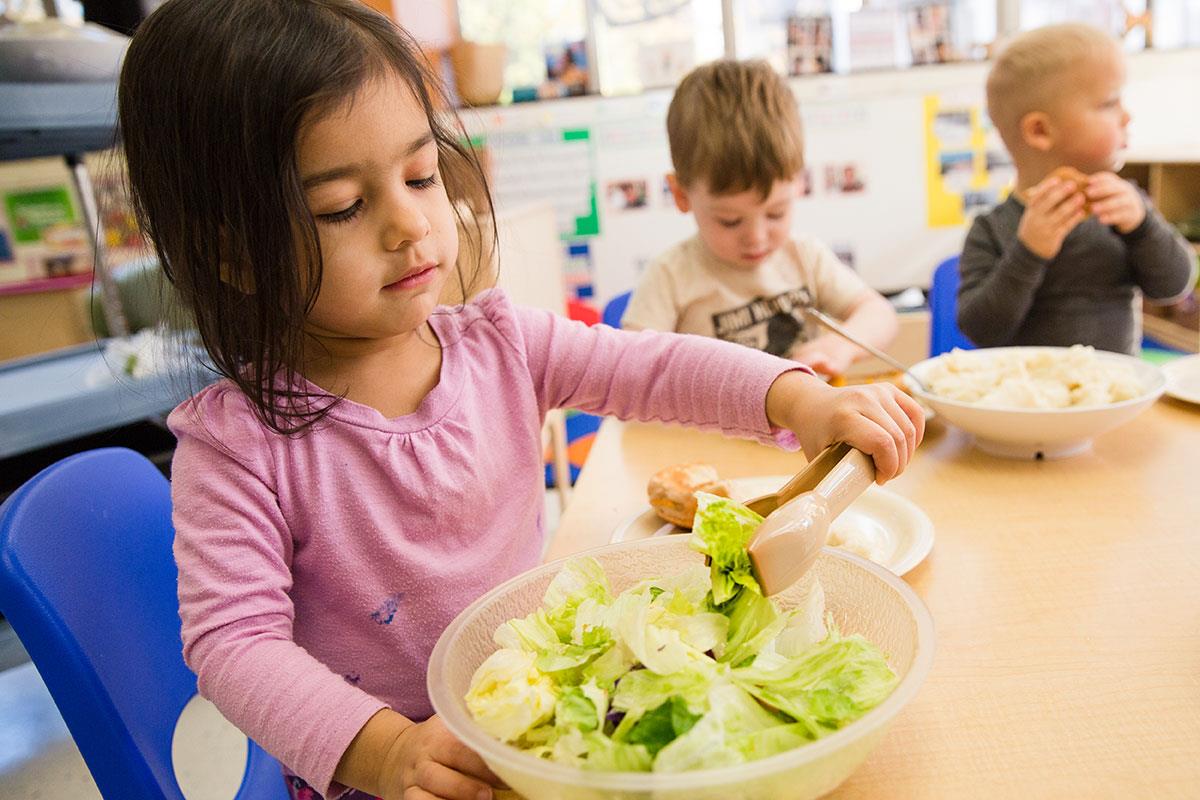Broccoli Rocks! 12 Tricks to Help You Raise a Great Eater
8-minute read
Article Overview:
Say hello to a world where broccoli rocks and sugary snacks take a back seat. Here’s how you can inspire your little ones to embrace a variety of healthy foods without the fuss:
- Introduce healthy foods early to build good eating habits and help your child avoid cravings for sugar and processed snacks.
- Prioritize nutrition over “kid-friendly” tastes to make healthy eating a natural choice for your child.
- Lead by example! Your grocery choices set the stage for your child’s nutritional path.
- Respect your child’s choice to eat (or not). Foster a stress-free eating environment by offering healthy choices without coercion.
- Avoid becoming a short-order cook. Preparing a single, healthy meal curbs picky eating and eases your workload.
- Teach polite food etiquette—no negative comments on foods we dislike.
- Pizza for dinner? Don’t stress over a single meal; look at nutritional intake over a week to gauge actual eating habits.
- Involve your child in cooking and shopping to spark their interest in trying and enjoying a wider range of foods.
Battles over broccoli, worries over white bread, debates about dessert: Welcome to the family food wars. It doesn’t have to be this way. We believe most parents want to raise their children to grow up loving healthy food and making good choices.
How do you do that? Well, we can’t say that it’s easy. But if you’re experiencing frequent food battles, it may be time to step back and find an eating approach that better fits your family. Not all of these ideas will feel right, but we hope you find them good, ahem, food for thought.

1. Children don’t have a genetic predisposition to avoid healthy foods.
Ever noticed how kids often skip the spinach and head right for the cookies? It’s not that they naturally dislike veggies. In fact, their food preferences are largely shaped by exposure and experience. The trick is to start them early on a wide variety of foods, keeping the sugary, processed snacks to a minimum. This way, they’ll learn to love food that nourishes their bodies.
2. Nutrition is more important than finding foods with “kid-friendly tastes.”
We all know the challenge: it’s mealtime, and the little ones are already suspicious of that green stuff on their plate. It’s tempting to put taste preferences above everything else, but prioritizing nutrition is super important for kiddos’ growth and development.
Think about smoothies with hidden veggies or making a rainbow out of fruits for a snack. It’s all about getting creative and a little bit sneaky (in the best way possible). Every parent faces these mealtime meltdowns, and it’s okay to take small steps. Sometimes, it’s about mixing a bit of what they love with what’s good for them. Over time, their taste buds will learn to love the good stuff!
3. It’s the parent’s job to buy healthy food and offer it—and it’s up to kids whether they choose to eat it or not.
Once the food is on the table, try not to control what and how much your child eats. It’s all about balance—providing wholesome meals without pressuring them with “Just one more bite; now take another bite of this.” When kids are hungry and only nutritious options are available, they tend to naturally reach for those foods on their own. This approach respects their growing independence and encourages them to tune into their hunger cues.
4. Serving one meal helps curb “picky eaters.”
It’s tempting to play chef and whip up different dishes to cater to everyone’s tastes. But here’s a little tip to make life easier: Make one meal for the whole family. It’s okay to acknowledge dislikes and tweak things a bit—like leaving mushrooms off a slice of lasagna if your child isn’t a fan. But try to gently encourage them to try new things. This makes meal prep simpler for you and teaches your kiddo to be polite guests when eating at someone else’s home.
5. Don’t “yuck” someone else’s “yum.”
It’s simple: If you don’t like something, that’s perfectly fine. Remind your little one that it’s respectful to try a little bite—or even just leave it—without a fuss. After all, someone took the time to prepare the meal, and a “no thank you” is a wonderful way to show appreciation.
6. Kids don’t eat as consistently as adults, so try not to get so concerned over a single meal.
It’s normal for kids to have ups and downs in their eating habits. If you’re concerned about your child’s nutrition, take a step back and look at the bigger picture—how they eat over a week, for example, instead of focusing on a single meal. By offering a variety of nutrient-dense choices, you’ll find they get all the nutrients they need over time, even if they barely touch their dinner one evening.
7. Rethink your fast go-to meals.
It’s Thursday night. It’s late. Everyone’s hungry. It’s a good idea to have a handful of simple, nutritious recipes ready to go. Plan for that. In your arsenal, you need five easy-to-make nutritious meals that you can pull out on a Thursday night when time just isn’t on your side. This way, you’re prepared, everyone’s happy, and you’ve managed to keep it wholesome and healthy! Some of our favs?
- Fruit kabobs with nut butter yogurt dip
- Back-to-school meal kits
- Rainbow pizza with pesto
- Whole grain granola
- Bean and cheese quesadillas
- Make your own rice bowl (use frozen rice and whatever veggie and protein odds and ends you have in the fridge)
- Baked potato bar (potatoes cook up quickly in the microwave, and toppings can range from veggies to cheese, chili, and more!)
- Breakfast for dinner (omelets to order, and a few cut oranges get the job done!)
8. Quell hunger meltdowns.
Always have a healthy snack ready when you pick up your kids from school or an activity.
9. Invite your child on a food adventure.
Encourage your children to explore the wonderful world of food by exploring the food world with them. Try out a new food truck. Once a month, choose a country and prepare a meal inspired by its cuisine. Visit local markets that offer foods from different cultures and try some new flavors. (This is where a kid who “doesn’t like spicy food” might discover the glory of chili-rubbed mango!)
10. Make food part of family fun.
A Canadian study found that kids who helped in the kitchen tried a wider variety of healthier foods and ate 10% more veggies than kids who didn’t help in the kitchen. The more comfy they are preparing food, the more apt they are to try it. Pro tip? Take them shopping! They can help pick out the ripest strawberries or the reddest tomatoes. With older kids, help them read labels and ask them to pick a cereal with less sugar. Give them the nutrition tools to help them make great choices for life!
*Note: If you have concerns about your child’s eating habits, consult a qualified medical professional.




